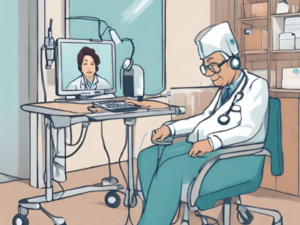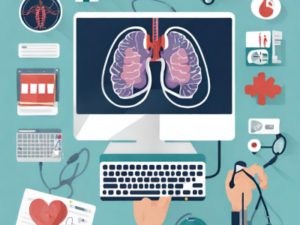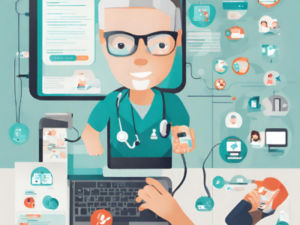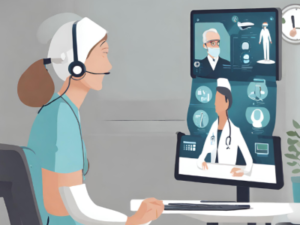Module 2: Tele-Communication Skills
- Description
- Curriculum
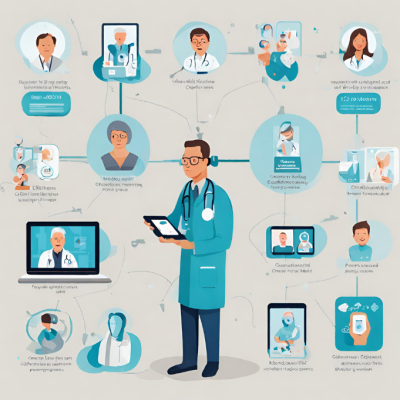
-
3LESSON 1: ACTIVE LISTENING, REFLECTIVE LISTENING, AND EMPATHIC LISTENING
Learning Outcomes
a) Knowledge
1. Understanding of Active Listening: Learners will acquire a comprehensive understanding of active listening, including its definition and significance in healthcare settings.
2. Knowledge of Reflective Listening: Participants will gain knowledge of reflective listening, including its purpose, techniques, and how it fosters effective communication and understanding.
3. Comprehension of Empathy: Learners will grasp the concept of empathy and its crucial role in healthcare, including how it contributes to the development of therapeutic relationships.
b) Skills
1. Active Listening Skills: Participants will develop the ability to actively listen during patient interactions, demonstrating techniques such as paraphrasing, clarifying, reflecting, and summarizing.
2. Reflective Listening Skills: Learners will acquire the skill to engage in reflective listening, allowing them to acknowledge patients' feelings and concerns effectively.
3. Empathic Listening skills: Participants will demonstrate proficiency in empathic listening, enabling them to understand and share patients' emotions, ultimately enhancing the therapeutic relationship.
c) Competence
1. Effective Communication Competence: Participants will demonstrate competence in effective communication with patients, showcasing active listening, reflective listening, and empathic listening skills in their interactions.
2. Patient-Centered Care Competence: Learners will be able to provide patient-centered care by applying active listening, reflective listening, and empathic listening techniques to understand and address patients' physical and emotional needs.
3. Building Trust and Rapport Competence: Participants will develop competence in building trust and rapport with patients, leading to enhanced patient satisfaction, adherence to treatment plans, and improved healthcare outcomes.
4. Cultural Competence: Learners will demonstrate cultural competence by applying active listening and empathic listening skills to understand and respect the diverse cultural backgrounds and beliefs of patients.
-
4Lesson 1 - Effective Interactions with Patients
-
5Lesson 1 - Ineffective Interactions with Patient
-
6Lesson 1 - Medical communication skills — Patient-centred interviewing
-
7LESSON 2: COMMUNICATION USING TECHNOLOGY – CHALENGES AND BARRIERS
Learning Outcomes
a) Knowledge
1. Understanding of Telenursing Communication Challenges: Learners will gain a comprehensive understanding of the challenges and barriers associated with communication in telenursing, including technical, clinical, cultural, socioeconomic, and generational factors.
2. Knowledge of Privacy and Security: Participants will acquire knowledge of the importance of privacy and security in telenursing and the steps required to ensure the confidentiality of patient information during remote consultations.
3. Awareness of Cultural Sensitivity: Learners will develop an awareness of the cultural differences that can impact communication in telenursing, as well as strategies to promote cultural sensitivity and effective cross-cultural interactions.
b) Skills
1. Technical Proficiency: Participants will develop technical skills required for effective telenursing communication, including proficiency in using telehealth platforms and addressing common technical issues that may arise during remote consultations.
2. Active Listening Skills: Learners will enhance their active listening skills, enabling them to engage fully with patients, elicit relevant information, and respond empathetically in a virtual setting.
3. Privacy and Security Protocols: Participants will develop the skills to implement privacy and security protocols, ensuring that patient data remains confidential and protected during telenursing interactions.
c) Competence
1. Effective Communication Competence: Participants will demonstrate competence in overcoming telenursing communication challenges, including the ability to adapt communication styles, address technical issues, and maintain patient-centered care remotely.
2. Cultural Competence: Learners will exhibit cultural competence by recognizing and respecting cultural differences, facilitating effective cross-cultural communication, and promoting culturally sensitive care.
3. Technical Troubleshooting Competence: Participants will be competent in troubleshooting common technical issues that may arise during telenursing consultations, ensuring uninterrupted communication with patients.
4. Privacy and Security Compliance Competence: Participants will demonstrate competence in adhering to privacy and security regulations and organizational policies, safeguarding patient information during telenursing encounters.
5. Patient Engagement Competence: Learners will develop competence in engaging and motivating patients in a virtual healthcare setting, fostering active participation in their own care.
6. Adaptability Competence: Participants will exhibit competence in adapting to evolving technology and communication tools in telenursing, staying current with best practices and advancements.
-
8Lesson 2 - Telehealth Communication: Quick Tips (part 1)
-
9Lesson 2 - Telehealth Communication: Quick Tips: DEMO (part 2)
-
10LESSON 3: SAFETY AND PRIVACY IN TELENURSING
Learning Outcomes
a) Knowledge
1. Understanding Environmental Factors: Learners will gain an understanding of the environmental factors that can impact telehealth privacy and security, including the challenges faced by vulnerable populations and the potential exposure of patients' living conditions.
2. Awareness of Technology Factors: Participants will become aware of various technology-related challenges in telehealth security, such as data security issues, digital literacy barriers, and reliance on technology for virtual healthcare.
3. Knowledge of Operational Factors: Learners will acquire knowledge about the operational considerations in telehealth, including reimbursement, payer denials, and staff training, which can influence the adoption and success of telehealth services.
4. Understanding of Informed Consent: Learners will understand the concept of informed consent and its significance in healthcare, particularly in the context of telenursing.
5. Knowledge of Informed Consent Elements: Participants will acquire knowledge of the key elements that constitute informed consent, including patient autonomy, understanding of the process, disclosure of risks and benefits, and legal and ethical compliance.
b) Skills
1. Assessing Environmental Factors: Participants will develop skills in assessing patients' environmental conditions and privacy concerns before initiating telehealth visits, ensuring that patient privacy is prioritized.
2. Mitigating Technology Challenges: Learners will acquire skills to address technology-related challenges in telehealth, including assisting patients with limited digital literacy and ensuring secure online communication.
3. Navigating Operational Considerations: Participants will develop skills related to navigating operational factors in telehealth, including verifying insurance coverage, using appropriate billing codes, and conducting training for staff and providers.
4. Obtaining Informed Consent: Participants will develop skills in effectively obtaining informed consent from patients in telenursing, ensuring that patients are aware of their rights and the nature of the telehealth encounter.
c) Competence
1. Environmental Adaptability: Learners will demonstrate competence in adapting telehealth practices to accommodate patients' diverse environmental circumstances, ensuring that privacy and security are maintained.
2. Technology Proficiency: Participants will exhibit competence in using telehealth technology securely and effectively, addressing technical issues, and ensuring data security during remote consultations.
3. Operational Efficiency: Participants will demonstrate competence in efficiently managing operational aspects of telehealth, such as reimbursement processes, payer denials, and staff training, to optimize telehealth services.
4. Ethical Practice: Participants will demonstrate competence in upholding ethical standards in telenursing by obtaining informed consent, respecting patient autonomy, and promoting transparency in the telehealth process.
5. Patient-Centered Care: Learners will exhibit competence in providing patient-centered care in telenursing, where patients actively participate in their care decisions, leading to improved healthcare outcomes and patient satisfaction.
-
11Lesson 3 - Informed Consent
-
12Lesson 3 - Informed Consent and Telemedicine
-
13LESSON 4: TELE-TRIAGE
Learning Outcomes
a) Knowledge
1. Understand the core principles of triage, including the significance of prioritizing patients based on the severity of their medical conditions.
2. Familiarize yourself with the various methods of conducting tele-triage, such as through websites, phone calls, or video calls.
3. Comprehend the advantages and disadvantages of tele-triage, including its potential limitations in gathering patient context and conducting physical examinations.
b)Skills
1. Develop the ability to effectively communicate with patients during tele-triage, paying special attention to nonverbal cues and reassurance.
2. Acquire proficiency in using telemedicine software and recording patient data in compliance with ICD-10 coding and HIPAA standards.
3. Hone your skills in initiating emergency procedures and dispatching assistance when necessary during tele-triage interactions.
c) Competence
1. Conduct tele-triage through various platforms to ensure patients receive appropriate instructions and healthcare advice.
2. Assess the urgency of patients' conditions and make informed decisions regarding the need for further medical care.
3. Competently organize and prioritize tele-triage tasks, effectively reducing overcrowding in emergency departments and providing support to patients in various healthcare settings.
-
14Lesson 4 - Telehealth Nurse Triage Call Procedures: Answering the Phone
-
15Lesson 4 - Telehealth Nurse Triage Call Procedures: Types of Difficult Calls
-
16LESSON 5: TELEHEALTH ENROLLMENT AND PATIENT ASSESSMENT
Learning Outcomes
a) Knowledge
1. Understanding the challenges of technology adoption, particularly among older individuals, is essential in ensuring equitable access to telemedicine services.
2. Knowledge of the barriers related to internet connectivity and technology access is vital for addressing disparities in telehealth utilization.
3. Familiarity with HIPAA compliance and the features of accessible telehealth platforms is crucial for safeguarding patient privacy and ensuring inclusivity.
b) Skills
1. Proficiency in conducting effective outreach to patients, assessing their technology needs, and offering alternative telehealth options, such as telephone appointments, demonstrates skill in patient engagement.
2. The ability to provide patients with information about free internet hotspots and other resources, while ensuring the protection of patient health information, showcases skills in patient support.
3. Collaborating with community assistance organizations and offering telehealth education to patients are skills that enhance accessibility and engagement in telemedicine.
c) Competence
1. Acquire competencies that involve sending materials, assessing patient accessibility, and ensuring a seamless connection, considering factors such as assistive technologies and interpreter services.
2. Guide patients through telehealth appointments, adapt to various communication needs, and provide support to patients who may require additional time or assistance.
3. Select and utilize accessible telehealth platforms while adhering to HIPAA standards, ensuring a secure and inclusive telemedicine experience for all patients.
-
17Lesson 5 - What Does A Telehealth Appointment Look Like?
-
18Lesson 5 - Four Ways to Have a Successful Telehealth Appointment
-
19DIGITAL RESOURCES
-
20SUMMARY + REFERENCES
-
21projekt TeleNursing_module 2

